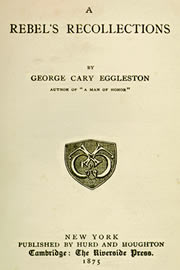George Cary Eggleston was born in Vevay,
Indiana, on November 26, 1839. His older brother, Edward
Eggleston, was also a writer and is more widely known
than George. When the boys were quite young, their father
died, leaving their mother to raise four children. A strong
influence in the boys’ early education was their high
school teacher, Julia Dumont. George attended Indiana Asbury
University, now known as DePauw, for a year. At that point
he was forced to become a school teacher himself due to
a lack of funds for continuing his education. His
brother’s famous book, The
Hoosier Schoolmaster,
was based on George’s experiences teaching.
 |
George Eggleston's
most famous novel |
At the age of seventeen, George inherited his
family’s plantation in Virginia, an event that drastically
changed his life. He attended college at Richmond and became
greatly involved in social and intellectual circles in the
South. He joined the Confederate Army, and his work, A
Rebel’s Recollections (1875), first published as
a series of papers, was written about his experiences during
the Civil War.
After the war, Eggleston moved around frequently, living
in Illinois, Mississippi, and New York. He married Marion
Craggs in 1868. He worked at various newspapers throughout
his life, including the New York World, where he
wrote for eleven years under Joseph Pulitzer. He was quite
prolific outside of his journalistic and editorial career,
writing novels, histories, biographies, and
an autobiography.
Much of Eggleston’s
writing was set in Virginia and South Carolina. However, some
of his boys’ novels took place in Indiana.
Jack Shelby is the story of a group
of brothers trying to establish a home for their family in
1838 in southern Indiana. It contains many passages that portray
the way that early pioneers
viewed the land. His writing also displays the strong contrast
between Indiana before and after the arrival of white settlers.
Eggleston gives an example of many settlers’
attitudes toward the land as they came into the area in Jack
Shelby: “It’s just plain, simple, black mud.
It’ll make fine cornfields some day when somebody drains
it with ditches. But just now it’s a nuisance”
(7). This thinking is precisely why almost all of Indiana’s
wetlands
were drained.
At the beginning of the seventh chapter of the same
book, Eggleston vividly describes the condition of Indiana as the
first pioneers moved in:
The road lay mainly through the dense forest
that clothed all that region, a forest composed chiefly of great,
smooth-barked beech trees, growing so thickly in their wide-spreading
upper parts that the sunlight found difficulty in sifting through.
Here and there in the beech woods, there stood clumps of hickory,
or ash, or oak, or walnut, and at certain points there were great
groves of sugar maples, or “sugar trees,” as they
were called in Southern Indiana, with few or no other trees growing
among them. These sugar trees were forest giants, rising to a
great height, as straight in their trunks as if they had been
so many arrows, and almost as black as ink, because every spring
their over-abundant sap, or “sugar water” oozed out
and dried on the bark to the color of ink.
There was little or no underbrush in these forests, whether the
trees happened to be beech, hickory, maple, oak or ash. The foliage
above was so dense that bushes could not grow beneath the trees.
Here and there a little open space permitted the sun to reach
the ground, and in such places there grew clumps of paw-paw bushes,
or little groves of leather-wood. But in the woods themselves
the spaces between the trees were as free of all undergrowth and
vines as if the forest had been a planted and carefully cultivated
grove. (56-57)
The forests were not the only part of the landscape
changed by settlers. Most of the prairies
were also converted into farmland. With much hard work, Eggleston’s
characters in Jack Shelby clear the prairie lands.
Jack, the oldest brother, explains to the
others, "[Prairie] grass sod has been growing there year
after year for ages perhaps, till its roots have struck deep
into the earth, and it’ll be hard work to get it into
good condition for corn by spring” (82).
Eggleston’s writing is particularly important
because it gives the perspective of early settlers moving
into Indiana when it was still heavily forested. He gives
us an idea of what they were thinking and feeling as they
first began to change the land into the Indiana we know today.
--RJC
Sources:
Eggleston, George Cary. Jack Shelby:
A Story of the Indiana Backwoods. Boston: Lothrop, Lee &
Shepard. Co., 1906.
---. A Rebel's Recollections. New York:
Hurd and Houghton, 1875.
Shumaker, Arthur W. A History Indiana
Literature. The Indiana Historical Society, 1962.
Banta, R.E. Indiana Authors and Their
Books, 1816-1916. Crawfordsville, IN: Wabash College, 1949.
Image:
Virginia Historical Society. In Daniel E.
Sutherland. "Virgina's Expatriate Artists." Virgina
Magazine of History and Biography 91 (1983): 149.
Eggleston, George Cary. A Rebel's Recollection.
Cover image.
|




